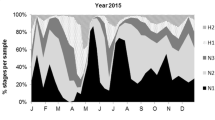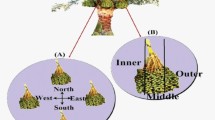Abstract
The Hindustan citrus mite, Schizotetranychus hindustanicus (Acari: Tetranychidae), is an invasive pest in South America and constitutes a threat to Brazilian citriculture. This study aimed to determine the contribution of weather variables to the seasonal abundance of S. hindustanicus and the best sampling scheme (sampling variable and unit) for this mite. Populations of S. hindustanicus were monitored monthly in an orange orchard for 31 months in Roraima state, Brazil. Eggs, mobile stages, and the symptoms caused by S. hindustanicus were sampled in different combinations of canopy quadrants, vertical tree strata, and branch sections. The optimal sampling variable and sampling unit for S. hindustanicus scouting were determined according to fidelity and precision criteria. Rainfall and high air temperature were the main factors reducing S. hindustanicus populations. The most suitable variable for S. hindustanicus sampling was egg count. The optimal sampling unit was a leaf collected in the central section of branches located in the middle tree stratum. In addition, the sample should be taken from the southwest quadrant. Collectively, this study adds to the understanding of S. hindustanicus population dynamics and provides a sampling scheme for better management of this pest.




Similar content being viewed by others
Data availability
The data that support the findings of this study are available from the corresponding author upon reasonable request.
References
Agritempo (2021) Pesquisa de Dados Meteorológicos para o Estado de RR. https://www.agritempo.gov.br/agritempo/jsp/PesquisaClima/index.jsp?siglaUF=RR. Accessed 23 November 2021
Barni PE, Rego ACM, Silva FCF, Lopes RA, Xaud HAM, Xaud MR, Barbosa RI, Fearnside PM (2021) Logging Amazon forest increased the severity and spread of fires during the 2015–2016 El Niño. For Ecol Manag 500:1–15. https://doi.org/10.1016/j.foreco.2021.119652
Bates D, Mächler M, Bolker B, Walker S (2015) Fitting linear mixed-effects models using lme4. J Stat Softw 67:1–48. https://doi.org/10.18637/jss.v067.i01
Binns MR, Nyrop JP, van der Werf W (2000) Sampling and monitoring in crop protection: the theoretical basis for developing practical decision guides. CABI, Wallingford
Castle S, Naranjo SE (2009) Sampling plans, selective insecticides and sustainability: the case for IPM as ‘informed pest management.’ Pest Manag Sci 65:1321–1328. https://doi.org/10.1002/ps.1857
D’Auria EM, Wohleb CH, Waters TD, Crowder DW (2016) Seasonal population dynamics of three potato pests in Washington state. Environ Entomol 45:781–789. https://doi.org/10.1093/ee/nvw046
Delignette-Muller ML, Dutang C (2015) Fitdistrplus: an R package for fitting distributions. J Stat Softw 64(4):1–34. https://doi.org/10.18637/jss.v064.i04
Ferragut F, Navia D, Ochoa R (2013) New mite invasions in citrus in the early years of the 21st century. Exp Appl Acarol 59:145–164. https://doi.org/10.1007/s10493-012-9635-9
Fidelis EG, Farias ES, Lopes MC, Sousa FF, Zanuncio JC, Picanço MC (2019) Contributions of climate, plant phenology and natural enemies to the seasonal variation of aphids on cabbage. J Appl Entomol 143(4):365–370. https://doi.org/10.1111/jen.12607
Figueirêdo FL, Fidelis EG, Pereira RS, Santos JC, Negrini M, Oliveira DC, Moraes GJ (2019) Geographical distribution of Schizotetranychus hindustanicus and associated mites in Roraima, Brazil. Neotrop Entomol 48(4):1–7. https://doi.org/10.1007/s13744-019-00704-6
Grousset F, Wistermann A, Steffen K, Petter F, Schrader G, Suffert M (2016) DROPSA Deliverable 1.3 Report for Oranges and Mandarins – Fruit pathway and Alert List’. https://www.eppo.int/media/uploaded_images/RESOURCES/special_projects/dropsa/4_orange_mandarin_report.pdf. Accessed 17 January 2022
Harrell FE (2019) Hmisc: Harrell miscellaneous. URL https://cran.r-project.org/package=Hmisc. Accessed 7 July 2021
Hirst S (1924) On some new species of red spider. Ann Mag Nat Hist 14:522–527
IBGE (2021) SIDRA - Produção Agrícola Municipal. https://sidra.ibge.gov.br/tabela/5457. Accessed 17 January 2022
Liu H, Zhao Z, Wang J, Li L, Ding W (2000) Temperature-dependent development and reproduction of the spider mite, Schizotetranychus bambusae Reck (Acari: Tetranychidae). Syst Appl Acarol 5:33–39. https://doi.org/10.11158/saa.5.1.4
Lopes MC, Ribeiro AV, Costa TL, Arcanjo LDP, Farias ES, Santos AA, Ramos RS, Araújo TA, Picanço MC (2019) Practical sampling plan for Liriomyza huidobrensis (Diptera: Agromyzidae) in tomato crops. J Econ Entomol 112(4):1946–1952. https://doi.org/10.1093/jee/toz091
Lüdecke D (2018) Ggeffects: Tidy data frames of marginal effects from regression models. J Open Source Softw 3(26):772. https://doi.org/10.21105/joss.00772
MAPA (2021) AGROSTAT—Estatísticas de Comércio Exterior do Agronegócio Brasileiro. https://indicadores.agricultura.gov.br/agrostat/index.htm. Accessed 17 January 2022
Moura MF, Picanço MC, Guedes RNC, Barros EC, Chediak M, Fidelis EG (2007) Conventional sampling plan for the green leafhopper Empoasca kraemeri in common beans. J Appl Entomol 131:215–220. https://doi.org/10.1111/j.1439-0418.2006.01113.x
Navia D, Marsaro AL Jr (2010) First report of the citrus hindu mite, Schizotetranychus hindustanicus (Hirst) (Prostigmata: Tetranychidae), in Brazil. Neotrop Entomol 39(1):140–143. https://doi.org/10.1590/S1519-566X2010000100021
Nienstaedt B, Marcano R (2009) Estudio de la biología del ácaro hindú de los cítricos Schizotetranychus hindustanicus (Hirst, 1924) (Acari: Tetranychidae), en tres tipos de alimentos. Entomotropica 24(2):51–56
Peacock L, Worner S, Sedcole R (2006) Climate variables and their role in site discrimination of invasive insect species distributions. Environ Entomol 35:958–963. https://doi.org/10.1603/0046-225X-35.4.958
Pedigo LP, Rice ME (2014) Entomology and pest management, 6th edn. Waveland Press, Long Grove
Pérez-Artiles L, Fuentes MP, Brochero CE, Gómez-Correa J, Hernández MJY, Monsalve García DA, Martínez MF (2021) Preference and incidence of Schizotetranychus hindustanicus (Hirst, 1924) (Acari: Tetranychidae) on citrus varieties. Rev Prot Veg 36(1):1–11
Picanço MC, Bacci L, Crespo ALB, Miranda MMM, Martins JC (2007) Effect of integrated pest management practices on tomato production and conservation of natural enemies. Agric For Entomol 9:327–335. https://doi.org/10.1111/j.1461-9563.2007.00346.x
Quirós M, Geraud-Pouey F (2002) Schizotetranychus hindustanicus (Hirst) (Acari: Tetranychidae), new spider mite pest damaging citrus in Venezuela, South América. In: Morales-Malacara JB, Rivas G (eds) XI International Congress of Acarology. Program and Abstract Book. Mexico City. Universidad Nacional Autónoma de México, pp 255–256
R Core Team (2019) R, a language and environment for statistical computing. Vienna, R Foundation for Statistical Computing. https://www.R-project.org. Accessed 08 August 2021
Rêgo AS, Teodoro AV, Maciel AGS, Sarmento RA (2013) Relative contribution of biotic and abiotic factors to the population density of the cassava green mite, Mononychellus tanajoa (Acari: Tetranychidae). Exp Appl Acarol 60:479–484. https://doi.org/10.1007/s10493-013-9667-9
Roy S, Muraleedharan N, Mukhopadhyay A (2014) The red spider mite, Oligonychus coffeae (Acari: Tetranychidae): its status, biology, ecology and management in tea plantations. Exp Appl Acarol 63:431–463. https://doi-org.ez103.periodicos.capes.gov.br/https://doi.org/10.1007/s10493-014-9800-4
Saeidi Z, Nemati A (2016) Relationship between temperature and developmental rate of Schizotetranychus smirnovi (Acari: Tetranychidae) on almond. Int J Acarol 43:142–146. https://doi.org/10.1080/01647954.2016.1234507
Saeidi Z, Nemati A, Riahi E (2020) Temperature-dependent development and life table parameters of Schizotetranychus smirnovi (Acari: Tetranychidae) on Almond. Syst Appl Acarol 25:1373–1383. https://doi.org/10.11158/saa.25.8.2
Santos-Filho HP, Magalhães AFJ, Coelho YS(2005) Citros: o produtor pergunta, a Embrapa responde. https://www.embrapa.br/busca-de-publicacoes/-/publicacao/653731/citros-o-produtor-pergunta-a-embrapa-responde. Accessed 17 January 2022
Sheikholeslam-Zadeh S, Sadeghi-Nameghi H (2010) First records of four mite species (Acari: Tetranychidae) in Iran. Appl Entomol Phytopathol 78:121–125
Silva ÉM, Crespo ALB, Farias ES, Bacci L, Queiroz RB, Picanço MC (2019) Conventional sampling plan for scouting Neoleucinodes elegantalis (Lepidoptera: Crambidae) eggs on tomato fruits. J Econ Entomol 112(5):2433–2440. https://doi.org/10.1093/jee/toz158
Silva FS, Lopes MC, Farias ES, Sarmento RA, Pereira PS, Picanço MC (2020) Standardized sampling plan for common blossom thrips management in melon fields from north Brazil. Crop Prot 134:105179. https://doi.org/10.1016/j.cropro.2020.105179
Southwood TRE, Henderson PA (2000) The sampling programme and the measurement and description of dispersion. In: Southwood TRE, Henderson PA (eds) Ecological methods. Blackwell Science, Oxford, pp 7–72
USDA (2022) U.S. Regulated Plant Pest List. https://www.aphis.usda.gov/aphis/ourfocus/planthealth/import-information/rppl. Accessed 17 January 2022
Acknowledgements
The authors thank the Brazilian Agricultural Research Corporation (Embrapa) (Nº 13.16.04.030.00.00) and the Brazilian National Council for Scientific and Technological Development (CNPq) (Nº 426034/2016-3) for financial support.
Author information
Authors and Affiliations
Contributions
EGF: planning and designing the study, funding acquisition, data analysis, writing original draft, review and editing. FLF: collecting field data and review. TMMGC: mite identification and review. DCO: collecting field data. ESF: data analysis and review and editing.
Corresponding author
Ethics declarations
Conflict of interest
The authors declare no competing interests.
Additional information
Publisher’s Note
Springer Nature remains neutral with regard to jurisdictional claims in published maps and institutional affiliations.
Rights and permissions
Springer Nature or its licensor holds exclusive rights to this article under a publishing agreement with the author(s) or other rightsholder(s); author self-archiving of the accepted manuscript version of this article is solely governed by the terms of such publishing agreement and applicable law.
About this article
Cite this article
Fidelis, E.G., Figueirêdo, F.L., Castro, T.M.M.G. et al. Sampling approaches of the Hindustan citrus mite (Schizotetranychus hindustanicus) in Brazilian citrus orchards and climatic factors affecting its population dynamics. Exp Appl Acarol 87, 207–218 (2022). https://doi.org/10.1007/s10493-022-00735-6
Received:
Accepted:
Published:
Issue Date:
DOI: https://doi.org/10.1007/s10493-022-00735-6




